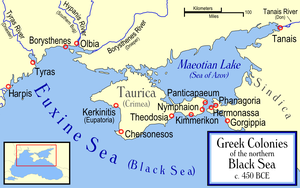Olbia (Black Sea)
Olbia was an ancient city. Their remains are near Parutyne in Mykolaiv Oblast , Ukraine .
Olbia at the mouth of the Bug on the border with ancient Dacia is considered one of the Ionian cities founded on the Black Sea . The Greek colony was founded by Miletus in 633 BC. Founded. Greeks, Scythians and Sarmatians are said to have lived together here.
history
Herodotus mentions a caravan route from Olbia to Central Asia. One of the amber roads , the route of the Greeks, which led from Samland to Greece, also touched Olbia and is likely to have contributed significantly to the wealth of this city described by Herodotus.
After Herodotus, the Scythians called themselves olbionites north and west of the Black Sea .
In the fourth century BC, the cities of Olbia and Miletus jointly defended themselves against the troops of the army of Alexander the Great , commanded by General Zopyrion . Towards the end of the third century BC, the city began to decline economically, and it eventually submitted to King Skiluros of Scythia. The place flourished again under Mithridates Eupator . However, under the rule of the Geten at the time of King Burebista , this ancient city came to an abrupt end.
Parts of Olbia were rebuilt under the rule of Rome. Dion of Prusa visited the city, which he called Borystenic Discourse after the river that flows into the Black Sea there. The city, which belongs to the Roman province of Moesia , was probably abandoned in the fourth century AD after it was burned down twice in the course of the so-called Gothic Wars.
Excavations
The area in which the remains of the ancient city of Olbia are located was owned by Count Mussin-Pushkin until 1902, who did not give permission for archaeological excavations. Boris Farmakovsky carried out professional excavations in the following period (1901 to 1915 and 1924 to 1926), during which numerous inscriptions and sculptures were found. The bronze coins in the shape of a dolphin are also remarkable. Archaeological excavations have been ongoing since 2016 under the direction of Alfred Twardecki from the National Museum in Warsaw .
As the site is gradually being eroded by the Black Sea, the days of archaeological excavations at this site are numbered.
Individual evidence
- ↑ Ulf Erichson, Wolfgang Weitschat: Baltic amber . Ribnitz-Damgarten 2008.
- ↑ Arnold Spekke: The Ancient Amber Routes and the Geographical Discovery of the Eastern Baltic. Stockholm 1957; Reprinted Chicago 1976
- ^ Max Ebert : Southern Russia in antiquity. Bonn 1921.
literature
- Carl Neumann : De rebus Olbiopolitanorum . Koenigsberg 1852.
- Edward Boucher James: Olbia . In: William Smith : Dictionary of Greek and Roman Geography. London 1854.
- Erich Diehl: The excavations in Olbia 1920–1930. In: Gnomon , Volume 8, 1932, pp. 545-548.
- Erich Diehl : Olbia 4. In: Paulys Realencyclopädie der classischen Antiquity Science (RE). Volume XVII, 2, Stuttgart 1937, Col. 2405-2423.
- Viktor F. Gajdukevič : The Bosporan Empire. 2nd edition, Akademie-Verlag, Berlin 1971.
- E. Belin de Ballu: Olbia. Cité antique du littoral north de la mer noire . Brill, Leiden 1972.
- Juri G. Vinogradov, Sergej D. Kryzikkij: Olbia. An ancient Greek city in the northwestern Black Sea region. Brill, Leiden 1995.
- John Boardman : Olbia and Berezan. The early pottery . In: Gocha R. Tsetskhladze (Ed.): The Greek Colonization of the Black Sea Area. Historical Interpretation of Archeology . Steiner, Stuttgart 1998, ISBN 3-515-07302-7 , pp. 201-204 ( Historia individual writings , volume 121).
- Askold I. Ivantchik: On the eve of colonization. The northern Black Sea region and the steppe nomads of the 8th – 7th centuries. Century BC In the classical literary tradition. Oral transmission, literature and history . German Archaeological Institute - Eurasia Department, Berlin et al. 2005, ISBN 5-89526-014-4 ( Pontus Septentrionalis , Volume 3).
- David Braund, SD Kryzhitskiy (Ed.): Classical Olbia and the scythian world. From the sixth century BC to the second century AD . Oxford University Press, Oxford et al. 2007, ISBN 978-0-19-726404-1 ( Proceedings of the British Academy , Volume 142).
- Site of the Polish Mission in Olbia
Coordinates: 46 ° 42 ' N , 31 ° 54' E

